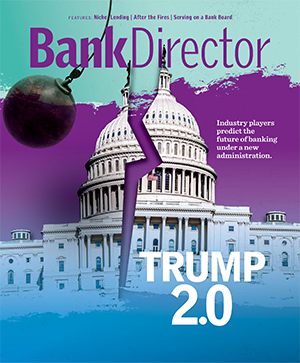
2019 Survey Results! Here’s How Banks Are Spending Money on Technology
Brought to you by CDW Financial Services

The desire to streamline customers’ experience and improve efficiency is driving bank technology strategies across the industry, as most executives and directors believe their offerings are “adequate,” according to Bank Director’s 2019 Technology Survey, sponsored by CDW.
The survey, conducted in June and July 2019, reflects the views of CEOs, technology executives and independent directors. It seeks to better understand bank strategies, staffing and budgets around technology and innovation, as well as banks’ relationships with legacy core providers and newer vendors.
Seventy-eight percent of survey respondents say that improving the customer experience is a top objective driving their bank’s strategy around the investment, development and implementation of technology. Seventy-two percent say that fueling efficiency is a top objective.
These strategic objectives are driving where banks are investing in technology: 68% say they’re investing in automation in fiscal year 2019, and 67% are investing money to enhance the bank’s digital channels.
Most banks rely on their core provider to advance these goals. The cores are the primary providers for many of the technologies used by banks today, including application programming interfaces (68% say that API technology is provided by the core), business process automation (43%), data aggregation (42%) and peer-to-peer (P2P) payments (47%).
That relationship isn’t stopping many banks from searching for new potential partners; 60% are willing to work with newer fintech startups. The survey finds that the use of alternate providers is gaining ground, in particular when it comes to the cloud (57%), data aggregation (25%) and P2P payments (29%).
Despite the rise of the digital channel, 51% of respondents say the branch is equally important to online and mobile channels when it comes to growing the bank. More than half indicate they’re upgrading branch and ATM technology.
Just 30% say that driving top-line growth fuels their technology strategy, which indicates that most banks see technology as a way to save money and time as opposed to generating revenue.
Key Findings
- Loyal to the Core. More than half of respondents say their core contract expires within the next five years. Sixty percent say they’re unlikely to switch to a new provider.
- But Banks Aren’t Satisfied. Just 21% say they’re completely satisfied with their core provider.
- Technology Pain Points. Sixty percent say their current core provider is slow to provide innovative solutions or upgrades to their bank, and almost half cite difficulty in implementing new solutions. These are major sticking points when 60% rely on their core provider to introduce innovative solutions.
- It’s All on IT. Almost three-quarters point to the senior technology executive as the individual responsible for identifying, developing and implementing technology solutions. Almost half task a management-level committee to make decisions about technology.
- Rising Budgets. Forty-five percent say their technology budget has risen between 5% to 10% for FY2019. Almost one-quarter report an increase of more than 15%. Responding banks budgeted a median of $750,000 for FY2019.
- Where the Money’s Going. In addition to automation, digital enhancements and branch improvements, banks are hiring consultants to supplement in-house expertise (50%), and bringing on additional employees to focus on technology and innovation (43%).
- Data Gap. Almost half describe their bank’s data analytics capabilities as inadequate.
- More Expertise Needed. Fifty-three percent say technology is on the agenda at every board meeting – up three points from last year’s survey. Yet, 80% say the board needs to enhance its technology expertise. Forty-three percent say they have a technology expert on the board.
- Cybersecurity Top of Mind. Protecting the bank from cyberattacks dominates board technology discussions, according to 96% of respondents. Many boards also focus on process improvements (63%) and implementing innovative customer-facing technology (46%).
To view the full results of the survey, click here.



